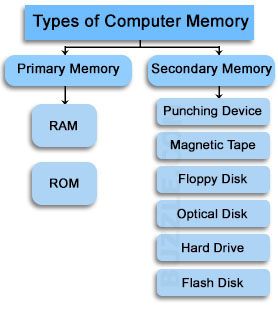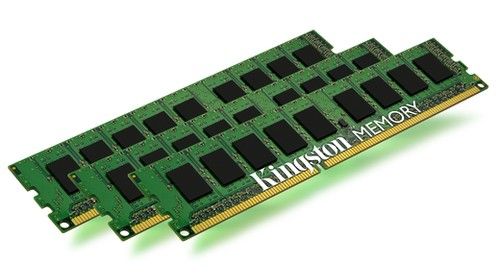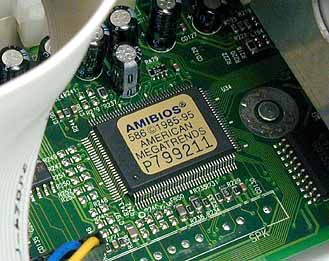COMPUTER MEMORY
Computer memory is a physical electronic device that is used to store applications and data, temporarily or permanently, as required by a computer and/or its user. Here is more on the different types of computer memory...
TYPES OF COMPUTER MEMORY
1. Primary Memory
i) RAM
ii) ROM
2. Secondary Memory
i) Punching Devices
ii) Magnetic Tape
iii) Floppy Disk
iv) Optical Discs (CD/DVD)
v) Hard Disk Drives
vi) Flash Drives
ii) Magnetic Tape
iii) Floppy Disk
iv) Optical Discs (CD/DVD)
v) Hard Disk Drives
vi) Flash Drives
1. PRIMARY MEMORY
Primary Memory (also called main memory), is used for immediate access of data by the processor. While primary memory storage demonstrates faster processing ability, it is costly and hence is not largely used for data storage. Most computer systems around the world use primary memory only for bootstrapping and related purposes, and use secondary memory devices for personal data storage purpose.
Primary Memory can be divided into two types - Random Access Memory (RAM) and Read Only Memory (ROM). RAM retains its contents as long as the power supply is on. A RAM chip is used as primary memory in most computers today. However, older computers (in the '80s) used ROM devices (floppy disks, magnetic tapes, paper clips or punches; but more prominently floppy disks) as primary memory mechanism.
Primary Memory can be divided into two types - Random Access Memory (RAM) and Read Only Memory (ROM). RAM retains its contents as long as the power supply is on. A RAM chip is used as primary memory in most computers today. However, older computers (in the '80s) used ROM devices (floppy disks, magnetic tapes, paper clips or punches; but more prominently floppy disks) as primary memory mechanism.
i) RAM (RANDOM ACCESS MEMORY)
RAM is a memory scheme within the computer system responsible for storing data on a temporary basis, so that it can be promptly accessed by the processor as and when needed. It is volatile in nature, which means that data will be erased once supply to the storage device is turned off. RAM stores data randomly and the processor accesses these data randomly from the RAM storage. The information stored in the RAM is typically loaded from the computer's hard disk, and includes data related to the operating system and certain applications. When the system is switched off, the RAM loses all stored information. The data remains stored on secondary storage though, and can be retained when the system is running again. Some of the earliest computers used delay-line format of computer storage. Most modern computers use an embedded RAM circuitry on the motherboard which reads data in bursts. So, modern RAM devices are not random memory devices as such; they are burst memory access devices, but the term RAM has stuck in everyday usage.
There are primarily two forms of RAM: Static RAM (SRAM) and Dynamic RAM (DRAM).
Static RAM: The most expensive of the lot, SRAM uses bistable latching circuitry to store one bit each, and hence is faster than its counterpart. Its high price prevents it from being widely used in everyday computing machines, but many modern machines use SRAM as the processor's cache register.
Dynamic RAM: Widely used in modern computers as primary memory, DRAM is slower than SRAM, but is inexpensive due to its one transistor-one capacitor paired assembly of memory storage.
There are primarily two forms of RAM: Static RAM (SRAM) and Dynamic RAM (DRAM).
Static RAM: The most expensive of the lot, SRAM uses bistable latching circuitry to store one bit each, and hence is faster than its counterpart. Its high price prevents it from being widely used in everyday computing machines, but many modern machines use SRAM as the processor's cache register.
Dynamic RAM: Widely used in modern computers as primary memory, DRAM is slower than SRAM, but is inexpensive due to its one transistor-one capacitor paired assembly of memory storage.
ii) ROM (READ ONLY MEMORY)
Unlike RAM, ROM is a permanent form of storage. ROM stays active regardless of whether power supply to it is turned on or off. In spite of this, ROM was used (in rare cases is still used) as the primary device for most computers back in the '80s. This was because ROM devices do not allow data stored on them to be modified. As the name itself suggests, data can only be accessed and read by the user, not overwritten, upgraded, or modified. This made it an ideal choice as bootable devices for old computers, programmable interpreters, and portable OS files carrier. The system programs stored on a ROM device could never be altered and hence, stayed secure for use.
The ROM memory used in modern computers is pre-programmed by the circuit manufacturer and cannot be altered by the user. The main reason why ROMs are not widely used in modern computer systems is because of the masking and error-retrieval costs. These processes are very expensive, and virtually negate the inexpensive manufacturing involved.
The ROM memory used in modern computers is pre-programmed by the circuit manufacturer and cannot be altered by the user. The main reason why ROMs are not widely used in modern computer systems is because of the masking and error-retrieval costs. These processes are very expensive, and virtually negate the inexpensive manufacturing involved.
2. SECONDARY MEMORY
Secondary memory is available on mass storage devices for permanent data storage. Data stored on a secondary device is retained even when it is not supplied any power. This data can be transported in most cases, and looks and appears the same on any machine, irrespective of where the data was first copied onto the secondary storage device.
Unlike primary memory, secondary memory is not directly accessible by the computer. When a computer needs to run or execute an application stored in secondary memory, it first brings it to primary memory storage for a while, to control and carry out its execution. Once execution of the application is done, the processor releases the application and restores its control and memory data with the secondary memory device.
Popular secondary memory devices include hard disk drives, flash drives (pen drives, memory cards etc.), and zip drives. A couple of decades ago, as the 'personal computer' (PC) revolution was gathering storm, especially in America, floppy disks had acquired almost a cult status amongst PC users. Eventually, floppy disks were phased out by a better technology - a contemporary form of the optical drive called the Compact Disc or CD. CDs came with better speed and larger storage alternatives as compared to floppies. DVDs eventually took over the mantle from CDs, courtesy their ability to store almost 4 times more data. Although DVDs are still widely used, the preferred devices of secondary storage nowadays are portable hard disk drives or flash drives.
Unlike primary memory, secondary memory is not directly accessible by the computer. When a computer needs to run or execute an application stored in secondary memory, it first brings it to primary memory storage for a while, to control and carry out its execution. Once execution of the application is done, the processor releases the application and restores its control and memory data with the secondary memory device.
Popular secondary memory devices include hard disk drives, flash drives (pen drives, memory cards etc.), and zip drives. A couple of decades ago, as the 'personal computer' (PC) revolution was gathering storm, especially in America, floppy disks had acquired almost a cult status amongst PC users. Eventually, floppy disks were phased out by a better technology - a contemporary form of the optical drive called the Compact Disc or CD. CDs came with better speed and larger storage alternatives as compared to floppies. DVDs eventually took over the mantle from CDs, courtesy their ability to store almost 4 times more data. Although DVDs are still widely used, the preferred devices of secondary storage nowadays are portable hard disk drives or flash drives.
i) PUNCH DEVICES
The essential data storage techniques of the '50s and '60s, punch tapes and punch cards have become passé since the advent of newer data storage formats.
Punch Tapes: A 0.1 mm thick paper strip was used to store data in the form of punched holes. A keyboard was used to punch the desired alphabet onto the tape. This alphabet was represented on the tape by a certain number and a select pattern of holes. A separate tape machine was used to send and receive these tapes for distance communication purposes. For computing purposes, stored data on the tapes would be read by the processing unit's inbuilt decoding machine.
Punch Cards: Primarily used in textile and handloom industries, punch cards stored instructions of operation for machines. Early digital computers made punch cards popular as data storage assemblies. Their working is pretty much similar to that of punch tapes, except for the fact that instead of paper strips, this technique uses cards about 3¼ inches × 7⅜ inches in size. Around the 1920s and 1930s, IBM hit upon a series of card innovations which enabled pre-punched data verification cards and cards with the ability to read alphabets, numbers, and signs (symbols) on a single multipurpose card.
Punch Tapes: A 0.1 mm thick paper strip was used to store data in the form of punched holes. A keyboard was used to punch the desired alphabet onto the tape. This alphabet was represented on the tape by a certain number and a select pattern of holes. A separate tape machine was used to send and receive these tapes for distance communication purposes. For computing purposes, stored data on the tapes would be read by the processing unit's inbuilt decoding machine.
Punch Cards: Primarily used in textile and handloom industries, punch cards stored instructions of operation for machines. Early digital computers made punch cards popular as data storage assemblies. Their working is pretty much similar to that of punch tapes, except for the fact that instead of paper strips, this technique uses cards about 3¼ inches × 7⅜ inches in size. Around the 1920s and 1930s, IBM hit upon a series of card innovations which enabled pre-punched data verification cards and cards with the ability to read alphabets, numbers, and signs (symbols) on a single multipurpose card.
ii) Magnetic Tape
Magnetic tape as a recording technique was invented in 1928. This formed the basis for magnetic digital information storage. This form of data storage gained immense popularity in the '70s, when magnetic tapes were wound around 10.6-inch reels. The device used for the read-write operations on these tapes is called a tape drive. Until the early 1980s, magnetic tape drives were huge external devices. With the introduction of IBM's 3480 family of magnetic tape cartridges, most magnetic tape storage assembly went inside the central processing unit.
Transferring data at around 7,200 characters/second, magnetic tapes store data in sequential order, which also can be accessed only in a sequential order. The magnetic tape's storage density and feasibility offered it a ready-made advantage against punched storage techniques. Even through the '90s, as floppy disks and compact discs were taking over the market, magnetic tapes held a fan-like following among large corporations for large-scale data storage. By the turn of the century, as solid state data storage took over, magnetic tapes lost hold with them too.
Transferring data at around 7,200 characters/second, magnetic tapes store data in sequential order, which also can be accessed only in a sequential order. The magnetic tape's storage density and feasibility offered it a ready-made advantage against punched storage techniques. Even through the '90s, as floppy disks and compact discs were taking over the market, magnetic tapes held a fan-like following among large corporations for large-scale data storage. By the turn of the century, as solid state data storage took over, magnetic tapes lost hold with them too.
iii) Hard Disk
The hard disk is also called fixed disk. It consists of one or more metal plates that are coated with magnetizable material. The plates of the disk are fixed permanently in the drive. Term hard disk is also called permanent disk and non-volatile disk.
A magnetic disk on which you can store computer data. The term hard is used to distinguish it from a soft, or floppy, disk. Hard disks hold more data and are faster than floppy disks. A hard disk, for example, can store anywhere from 10 to more than 100 gigabytes.
A single hard disk usually consists of several platters. Each platter requires two read/write heads, one for each side. All the read/write heads are attached to a single access arm so that they cannot move independently. Each platter has the same number of tracks, and a track location that cuts across all platters is called a cylinder. For example, a typical 84 megabyte hard disk for a PC might have two platters (four sides) and 1,053 cylinders.
A single hard disk usually consists of several platters. Each platter requires two read/write heads, one for each side. All the read/write heads are attached to a single access arm so that they cannot move independently. Each platter has the same number of tracks, and a track location that cuts across all platters is called a cylinder. For example, a typical 84 megabyte hard disk for a PC might have two platters (four sides) and 1,053 cylinders.
iv) Floppy Disk
Floppy diskette is also called simple a diskette or a disk. It is a small flexible plastic disk that is coating with magnetizable material. It was invented by IMB in early 1960s. Nowadays, floppy disks are available in the two sizes 5.25 inch diameter disk and 3.5 inch diameter disk.
Floppies come in three basic sizes:8-inch:The first floppy disk design, invented by IBM in the late 1960s and used in the early 1970s as first a read-only format and then as a read-write format. The typical desktop/laptop computer does not use the 8-inch floppy disk.
5��-inch: The common size for PCs made before 1987 and the predecessor to the 8-inch floppy disk. This type of floppy is generally capable of storing between 100K and 1.2MB (megabytes) of data. The most common sizes are 360K and 1.2MB.
3��-inch: Floppy is something of a misnomer for these disks, as they are encased in a rigid envelope. Despite their small size, microfloppies have a larger storage capacity than their cousins -- from 400K to 1.4MB of data. The most common sizes for PCs are 720K (double-density) and 1.44MB (high-density). Macintosh's support disks of 400K, 800K, and 1.2MB.
v) Optical Drives CD/DVD
Philips and Sony collaborated in the '70s on a project to create a new digital audio disc. This collaboration brought together the optical disc drive technologies both the companies were earlier separately working on. Launched in 1982-83, the Compact Disc (CD) eventually went on from being an audio disc to a data storage device.
computer-memory
The DVD, (originally Digital Video Disc, but later amended to Digital Versatile Disc) format was based on the CD format, and was developed together by Philips, Sony, Toshiba, and Panasonic around the early '90s. It was launched in 1995 and became an instant success by the virtue of being same size as a CD yet offering almost 4 times its memory space. While data storage isn't forfended, DVDs are mostly used for audio and video recording/storage/playback purposes.
In the late '90s, the popularity of CDs took a major three-way hit. While the launch of DVD had already put it out of favor with video enthusiasts, its audio and data storage purposes also waned in lieu of advancing technology. Affordable portable hard disk drives and flash drives drove CDs out as a preferred form of data storage. On the other hand, the easy availability of MP3 players and the legendary rise of Apple's iPod, practically drove audio CDs out of the market. The DVD too has found successors in the form of HD DVD and Blu-ray discs, and is in the gradual process of being phased out from regular use.
computer-memory
The DVD, (originally Digital Video Disc, but later amended to Digital Versatile Disc) format was based on the CD format, and was developed together by Philips, Sony, Toshiba, and Panasonic around the early '90s. It was launched in 1995 and became an instant success by the virtue of being same size as a CD yet offering almost 4 times its memory space. While data storage isn't forfended, DVDs are mostly used for audio and video recording/storage/playback purposes.
In the late '90s, the popularity of CDs took a major three-way hit. While the launch of DVD had already put it out of favor with video enthusiasts, its audio and data storage purposes also waned in lieu of advancing technology. Affordable portable hard disk drives and flash drives drove CDs out as a preferred form of data storage. On the other hand, the easy availability of MP3 players and the legendary rise of Apple's iPod, practically drove audio CDs out of the market. The DVD too has found successors in the form of HD DVD and Blu-ray discs, and is in the gradual process of being phased out from regular use.
vi) Flash Drives
A flash drive is a data storage device that uses flash memory for storage purposes. Typical in design, flash drives are light-weight and small in design; and are hence easily portable. Flash drives operate from the power supplied by a computer's USB port (the port in which they are plugged in). The data on it can be erased and re-programmed as per the user's requirements. It only has a specific number of erase and write cycles that it can withstand, after which it creates a tendency to lose out on the stored information. Memory cards and USB flash drives are some modes of this type of memory storage. Low cost, minimal power consumption, and portable features make flash drives extremely desirable and popular in modern times.
The concept of computer memory has evolved since the first electronic computer (ENIAC) was set up in 1946 with a primitive read only pre-stored programming mechanism. ENIAC used function tables for storing instructions. Its maximum storage capacity was 600 two-hundred digit decimal instructions. The way data is stored today and the volumes in which it can be stored today is like a million miles ahead of that.
Memory management has become an important concept in every computer programmer's textbook. Corporations and computer scientists keep researching for newer, simpler, easier, and cost-effective methods of memory storage that can hold larger and larger capacity of data than what is currently possible. Computer memory and its evolution is a constant process, much like the rest of technology. It has changed multifold over the last few decades; expect it to change multifold in the decades to come.
The concept of computer memory has evolved since the first electronic computer (ENIAC) was set up in 1946 with a primitive read only pre-stored programming mechanism. ENIAC used function tables for storing instructions. Its maximum storage capacity was 600 two-hundred digit decimal instructions. The way data is stored today and the volumes in which it can be stored today is like a million miles ahead of that.
Memory management has become an important concept in every computer programmer's textbook. Corporations and computer scientists keep researching for newer, simpler, easier, and cost-effective methods of memory storage that can hold larger and larger capacity of data than what is currently possible. Computer memory and its evolution is a constant process, much like the rest of technology. It has changed multifold over the last few decades; expect it to change multifold in the decades to come.









No comments:
Post a Comment